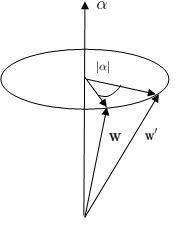Let us consider an infinitesimal rotation  directed along the axis about which the rotation takes place.We then have
directed along the axis about which the rotation takes place.We then have

The changes  (in the radial vector
(in the radial vector  of the particle) due to such a rotation is:
of the particle) due to such a rotation is:

so


The expression

is the operator of an infinitesimally small rotation. We recognize the equation

Therefore, the infinitesimal rotation operator is

This expression is only until the first order correction. The actual rotation operator is calculated by applying this operator N times where N goes to infinity. Doing so, we get the rotation operator for finite angle

In this form, we recognize that angular momentum is the generator of rotation. And we can write the equation relating the initial vector before rotation with the transformed vector as

This expression of the rotation operator is also valid when the rotation angle is not infinitesimal. What's more, this equation also implies that if we have a scalar instead of  , it would be invariant. We can also calculate the effect of the unitary operator
, it would be invariant. We can also calculate the effect of the unitary operator  on the states:
on the states:


This is the wavefunction evaluated at a rotated point.
A sample problem
















